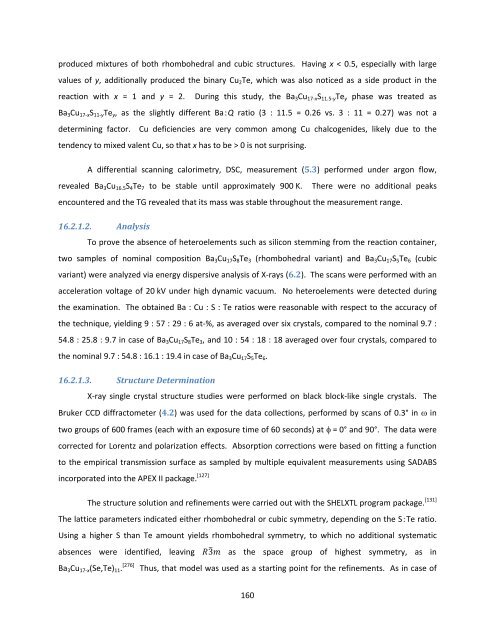Exploration and Optimization of Tellurium‐Based Thermoelectrics
Exploration and Optimization of Tellurium‐Based Thermoelectrics
Exploration and Optimization of Tellurium‐Based Thermoelectrics
Create successful ePaper yourself
Turn your PDF publications into a flip-book with our unique Google optimized e-Paper software.
produced mixtures <strong>of</strong> both rhombohedral <strong>and</strong> cubic structures. Having x < 0.5, especially with large<br />
values <strong>of</strong> y, additionally produced the binary Cu2Te, which was also noticed as a side product in the<br />
reaction with x = 1 <strong>and</strong> y = 2. During this study, the Ba3Cu17‐xS11.5‐yTey phase was treated as<br />
Ba3Cu17‐xS11‐yTey, as the slightly different Ba:Q ratio (3 : 11.5 = 0.26 vs. 3 : 11 = 0.27) was not a<br />
determining factor. Cu deficiencies are very common among Cu chalcogenides, likely due to the<br />
tendency to mixed valent Cu, so that x has to be > 0 is not surprising.<br />
A differential scanning calorimetry, DSC, measurement (5.3) performed under argon flow,<br />
revealed Ba3Cu16.5S4Te7 to be stable until approximately 900 K. There were no additional peaks<br />
encountered <strong>and</strong> the TG revealed that its mass was stable throughout the measurement range.<br />
16.2.1.2. Analysis<br />
To prove the absence <strong>of</strong> heteroelements such as silicon stemming from the reaction container,<br />
two samples <strong>of</strong> nominal composition Ba3Cu17S8Te3 (rhombohedral variant) <strong>and</strong> Ba3Cu17S5Te6 (cubic<br />
variant) were analyzed via energy dispersive analysis <strong>of</strong> X‐rays (6.2). The scans were performed with an<br />
acceleration voltage <strong>of</strong> 20 kV under high dynamic vacuum. No heteroelements were detected during<br />
the examination. The obtained Ba : Cu : S : Te ratios were reasonable with respect to the accuracy <strong>of</strong><br />
the technique, yielding 9 : 57 : 29 : 6 at‐%, as averaged over six crystals, compared to the nominal 9.7 :<br />
54.8 : 25.8 : 9.7 in case <strong>of</strong> Ba3Cu17S8Te3, <strong>and</strong> 10 : 54 : 18 : 18 averaged over four crystals, compared to<br />
the nominal 9.7 : 54.8 : 16.1 : 19.4 in case <strong>of</strong> Ba3Cu17S5Te6.<br />
16.2.1.3. Structure Determination<br />
X‐ray single crystal structure studies were performed on black block‐like single crystals. The<br />
Bruker CCD diffractometer (4.2) was used for the data collections, performed by scans <strong>of</strong> 0.3° in in<br />
two groups <strong>of</strong> 600 frames (each with an exposure time <strong>of</strong> 60 seconds) at = 0° <strong>and</strong> 90°. The data were<br />
corrected for Lorentz <strong>and</strong> polarization effects. Absorption corrections were based on fitting a function<br />
to the empirical transmission surface as sampled by multiple equivalent measurements using SADABS<br />
incorporated into the APEX II package. [127]<br />
The structure solution <strong>and</strong> refinements were carried out with the SHELXTL program package. [131]<br />
The lattice parameters indicated either rhombohedral or cubic symmetry, depending on the S:Te ratio.<br />
Using a higher S than Te amount yields rhombohedral symmetry, to which no additional systematic<br />
absences were identified, leaving 3 as the space group <strong>of</strong> highest symmetry, as in<br />
Ba3Cu17‐x(Se,Te)11. [276] Thus, that model was used as a starting point for the refinements. As in case <strong>of</strong><br />
160
















